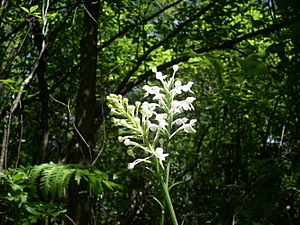White fringed orchid facts for kids
Quick facts for kids White fringed orchid |
|
|---|---|
 |
|
| A beautiful white fringed orchid flower | |
| Conservation status | |
| Scientific classification | |
| Genus: |
Platanthera
|
| Species: |
blephariglottis
|
| Varieties | |
|
|
| Synonyms | |
Sources: Botanicus, IPNI, ITIS, FNA, MBG |
|
The Platanthera blephariglottis, also known as the white fringed orchid, is a type of orchid. It belongs to the Platanthera group of plants. This beautiful flower is considered rare in some places. For example, it is an endangered species in Connecticut and Ohio. It is a threatened species in Florida, Maryland, and Rhode Island. In New York, it is vulnerable to being over-collected. It is also at risk in Quebec.
The name Platanthera comes from Greek words. It means "flat flower" or "wide anthered." The word blephariglottis also comes from Greek. Blepharis means "eyelash" or "fringed," and glottis means "tongue." So, its name describes its fringed, tongue-like petals.
Contents
What Does the White Fringed Orchid Look Like?
The white fringed orchid blooms from late spring to summer. This plant can grow quite tall, from about 8 to 110 centimeters (3 to 43 inches). You can find it growing in wet areas like bogs. It also likes the moist banks of lakes and rivers. It grows mainly in eastern North America.
Stems and Leaves
This orchid usually has at least two leaves, but often more. These leaves spread out or point upwards along the stem. Their shapes can vary. They might be long and narrow, or wider and more oval-shaped.
Flowers
The orchid has many showy white flowers grouped together. They form a dense or loose spike. The side parts of the flower, called sepals, bend downwards and outwards. The Petals are mostly fringed, like an eyelash. They are long and narrow, getting thinner towards where they attach to the flower.
Where Does This Orchid Grow?
The white fringed orchid often grows in sphagnum moss. It also likes other acidic mosses. You can find it in open, wet areas. These include bogs with black spruce or tamarack trees. It also grows on the wet shores of lakes and in open, wet meadows.
Native Regions
This orchid is native to many parts of North America:
- Eastern Canada:
- Northeastern United States:
- North-Central United States:
- Southeastern United States:
- South-Central United States:
Sources: NRCS, WSH
See also
 In Spanish: Platanthera blephariglottis para niños
In Spanish: Platanthera blephariglottis para niños


